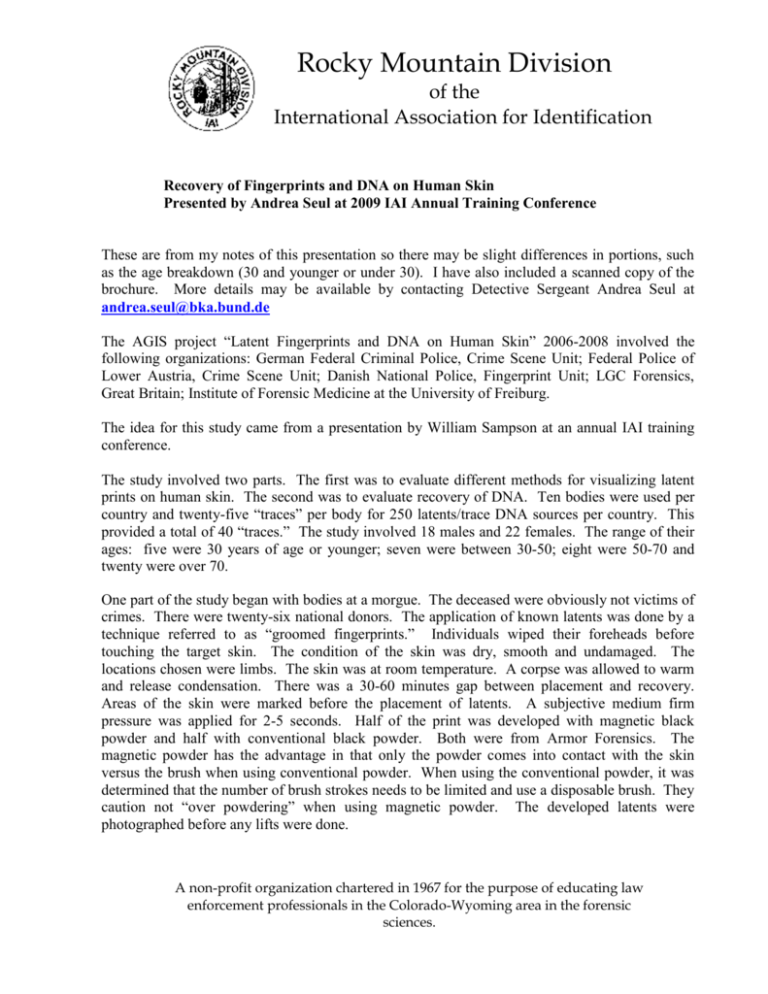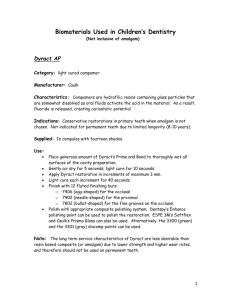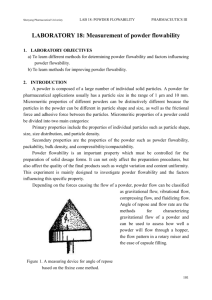IAI Latents/DNA on skin - Rocky Mountain Division of the IAI
advertisement

Rocky Mountain Division of the International Association for Identification Recovery of Fingerprints and DNA on Human Skin Presented by Andrea Seul at 2009 IAI Annual Training Conference These are from my notes of this presentation so there may be slight differences in portions, such as the age breakdown (30 and younger or under 30). I have also included a scanned copy of the brochure. More details may be available by contacting Detective Sergeant Andrea Seul at andrea.seul@bka.bund.de The AGIS project “Latent Fingerprints and DNA on Human Skin” 2006-2008 involved the following organizations: German Federal Criminal Police, Crime Scene Unit; Federal Police of Lower Austria, Crime Scene Unit; Danish National Police, Fingerprint Unit; LGC Forensics, Great Britain; Institute of Forensic Medicine at the University of Freiburg. The idea for this study came from a presentation by William Sampson at an annual IAI training conference. The study involved two parts. The first was to evaluate different methods for visualizing latent prints on human skin. The second was to evaluate recovery of DNA. Ten bodies were used per country and twenty-five “traces” per body for 250 latents/trace DNA sources per country. This provided a total of 40 “traces.” The study involved 18 males and 22 females. The range of their ages: five were 30 years of age or younger; seven were between 30-50; eight were 50-70 and twenty were over 70. One part of the study began with bodies at a morgue. The deceased were obviously not victims of crimes. There were twenty-six national donors. The application of known latents was done by a technique referred to as “groomed fingerprints.” Individuals wiped their foreheads before touching the target skin. The condition of the skin was dry, smooth and undamaged. The locations chosen were limbs. The skin was at room temperature. A corpse was allowed to warm and release condensation. There was a 30-60 minutes gap between placement and recovery. Areas of the skin were marked before the placement of latents. A subjective medium firm pressure was applied for 2-5 seconds. Half of the print was developed with magnetic black powder and half with conventional black powder. Both were from Armor Forensics. The magnetic powder has the advantage in that only the powder comes into contact with the skin versus the brush when using conventional powder. When using the conventional powder, it was determined that the number of brush strokes needs to be limited and use a disposable brush. They caution not “over powdering” when using magnetic powder. The developed latents were photographed before any lifts were done. A non-profit organization chartered in 1967 for the purpose of educating law enforcement professionals in the Colorado-Wyoming area in the forensic sciences. Two products were evaluated for the lifting media for the powdered latent. These were a siliconebased casting material from Isomark and a white gel foil from Teiva. The lifts were swabbed with cotton swabs in a laboratory. They found that a lot of cellular material stayed in the Isomark lift so recovery of DNA was not as good as the gel foil lift. The organic extracts of the magnetic powder were murky, so they used “NucleoSpin” to clean up the extract. The latents were evaluated according to national standards into four categories. Identification, elimination, indication of touch (fingermark), and no result. The data of the study were presented in terms of frequencies and percentages. For latents the best results came with magnetic powder and Isomark cast/lift. The DNA evaluation was divided into five categories. No recovery; complete DNA of corpse; partial interpretive mixture of corpse and latent donor; completely interpretable mixture of corpse and latent donor; and complete donor profile. The DNA results were totally independent of the quality of the latent. Future work will include fluorescent powder, DNA recovery techniques (tape and swabs), and optimization of the DNA extraction. The manuscript of the study and its results has been submitted to the Journal of Forensic Sciences. Tom J. “Grif” Griffin RMD Regional Representative September 20, 2009








